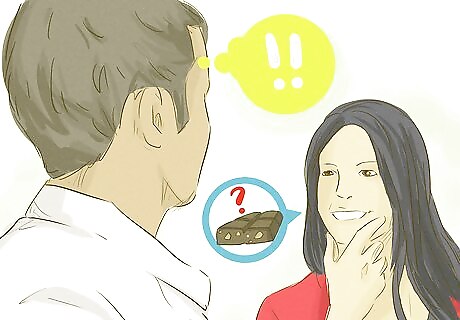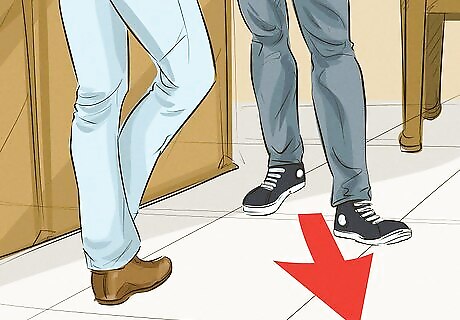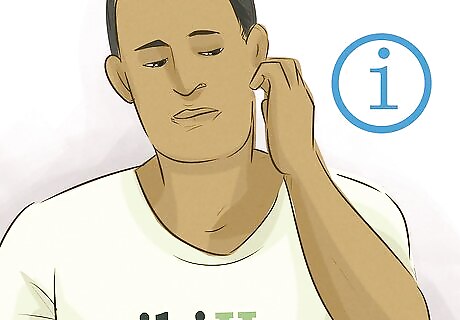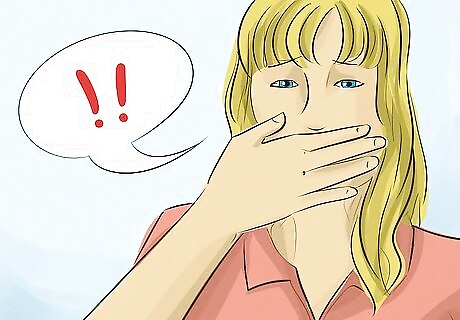
views
Using Questions and Verbal Tricks to Catch Someone in a Lie

Tell the story in your own words. When you suspect someone of something, tell the story how you think it happened. This is one of the best ways to catch a liar since most people can't resist filling in details, despite the fact that the person won't confess or hasn't told the truth beforehand. For instance, you could say, "Here's what I think happened. You saw there was only one milk chocolate bar left, and you wanted to save it for yourself, right? And then you decided to sneak it away to hide it in the night stand." You can even replace details you know to be true with lies, such as calling it a milk chocolate bar when it was actually dark, as the person will want to jump in to correct you. This technique often elicits more of a response than direct questions.

Use leading questions to ferret out a lie. Oftentimes, you can't determine a lie just from talking with a person. However, you can use nonverbal cues to help point you in the right direction, so you know what to check up on to see if the person is lying. For example, if you're wondering if your spouse hid the last bar of chocolate, you could ask a series of questions to help lead to the answer, such as "If you had hid the chocolate, would you have hidden it in the night stand? Would you have hidden it in the refrigerator? Would you have hidden it in your purse?" If your spouse reacts to one of the questions, such as rubbing their eyes, that could indicate where the chocolate is hidden, though you should check up on it to make sure, not accuse your spouse of lying outright.

Surprise the person. Sometimes catching the person off guard is enough to bring out a lie. That is, the person has probably practiced what they were going to tell you, particularly if it's a big lie. In that case, try asking questions that are surprising or startling, which can throw the liar off their rhythm, possibly catching them in a lie. For example, you could ask your spouse, "Did the chocolate have nuts in it?" That question may seem out of the blue, particularly if you're asking whether your spouse ate or hid the chocolate.

Try a volatile conundrum. A volatile conundrum is in someways similar to catching the liar by surprise. However, you can question a person using this technique without them knowing. Basically, you're forcing them to answer a question that could catch them in a lie either way, and they have to think on their feet to answer the question. For example, if your spouse is saying they didn't hide the last bit of chocolate, you could ask, "Well, that's funny, because I thought I saw a bar of it last night." The key here is you don't even have to be telling the truth. The other person doesn't know if you are or not. If they're telling the truth, then they'll likely reply quickly with something like, "Silly, we finished that box last week." If they're lying, they're more likely to say something like, "Oh, um, yeah, I'm not sure what you're talking about," or "Um, no, I don't think there was." If you think the person is telling the truth, you can play it off as a mistake, such as, "Oh, I guess I forgot I ate the last one a week ago. So, what's for dinner?" A redirect after the question can help move the conversation onward.

Gather evidence. Once you've figured out a direction to investigate, you can gather evidence. Check up on the lead you figured out. For instance, if you suspect you know where your spouse hid the chocolate, you can go and check that location. In another example, you could check a car's history if you suspect a salesperson is lying to you about it. One way to gather evidence is to use social media. Sometimes, a person may contradict themselves by posting on social media. For instance, they may tell you they are going out with friends to movie, but they might accidentally check in at a bar with their phone.

Hold up your evidence for a confession. If you find evidence to the contrary of what the person is saying, you can confront them. However, if you want more information out of the person, you should only allude to the evidence, rather than addressing it directly. If a person has direct evidence against them, they may not want to talk any more about it. For example, you could say, "Isn't it possible you hid the chocolate in the night stand?" when you've already gone and found the chocolate. You can also use social media evidence the same way: "So, did you only go to the movie, or did you go anywhere else?"
Checking Their Body Language

Start with a baseline of questions. When looking for nonverbal cues to indicate deception, you have to establish the person's normal behavior. In other words, what may indicate lying in one person may just be a nervous habit in another person. To establish a baseline, ask a few easy-going questions at first to put the person at ease. Pay attention to any body language the person normally employs before moving on to harder, more relevant questions. For example, you could ask things like, "It sure has been hot, hasn't it?" or "How have you been today?"

Pay attention to their eyes. When someone is lying, they tend to do one of two things: They may avoid eye contact altogether, looking around the room or at your forehead rather than make eye contact. On the other hand, they may make too much eye contact, meaning they stare at you more than is normal. Both of these tactics could indicate someone is lying. A person may also lower their eyes when lying or rub them to block your gaze. A person may also blink more if they are lying.

Check where their body is pointing. Sometimes, a liar will physically move their body when they're lying. Usually, that means they will point their body away from you. One place to check for this type of body positioning is a person's feet: what direction are they facing? If the person moves them to point away from you, they could be lying.

Watch for fidgeting. Some people are just fidgeters, meaning they can't keep still no matter what. However, an increase in fidgeting is likely an indication of nervousness. In turn, that could mean the person is not being completely truthful, so be on the lookout for fidgeting.

Understand why nonverbal cues may not be indicative of lying. While certain nonverbal cues are supposed to indicate lying, these cues are generalities taken from observing a variety of individuals. In other words, not everyone will display the same nonverbal cues, and some cues, such as extraneous blinking, are difficult to distinguish from normal blinking. In addition, when you're looking for nonverbal cues, you're making the assumption that lying puts the person under stress, to the point that their body will betray them. That may be true when it comes to big lies, such as when a person is trying to get away with murder. However, most people tell little white lies all the time, so it becomes natural to them. When lying comes naturally, the body is less likely to betray the person, so everyday lies are much harder to pick out. It's also true that sometimes these nonverbal cues will be present in a person who's telling the truth because the truth is stressful. It's the stress of the situation that produces these nervous habits rather than telling a lie.
Listening to the Person's Speech Patterns

Check if they use contractions. Often times, people become more emphatic when they are lying. In turn, they may mean they use fewer contractions, as contractions are less emphatic than using more words to emphasize the lie. For example, a liar may say "I absolutely did NOT eat the last ice cream bar," rather than, "I didn't eat the last ice cream bar."

Request the person tell their story backwards. Another way to check for lies is to request that the person tell you their story again, but backwards this time. If the person is lying, they are much more likely to slip up when telling it backwards than when telling it forward. Plus, they are more likely to show nonverbal cues of lying when telling it backwards. However, some people may just find telling a story backwards difficult and will show signs of nervousness.

Check if they keep their answers short and sweet. Often, someone who is lying will shorten rather than elongate answers. That's because the person has to come up with the details of a lie, while real life provides ample details when a person isn't lying. If a person seems particularly recalcitrant, that could indicate they are lying.

Listen for verbal tics. While everyone inserts an "um," "ah," "erm," or "like" sometimes, liars may rely on this verbal tics more often because they are trying to fill in the details. If you notice someone suddenly starts using more of these inserts, they could be lying to you.



















Comments
0 comment